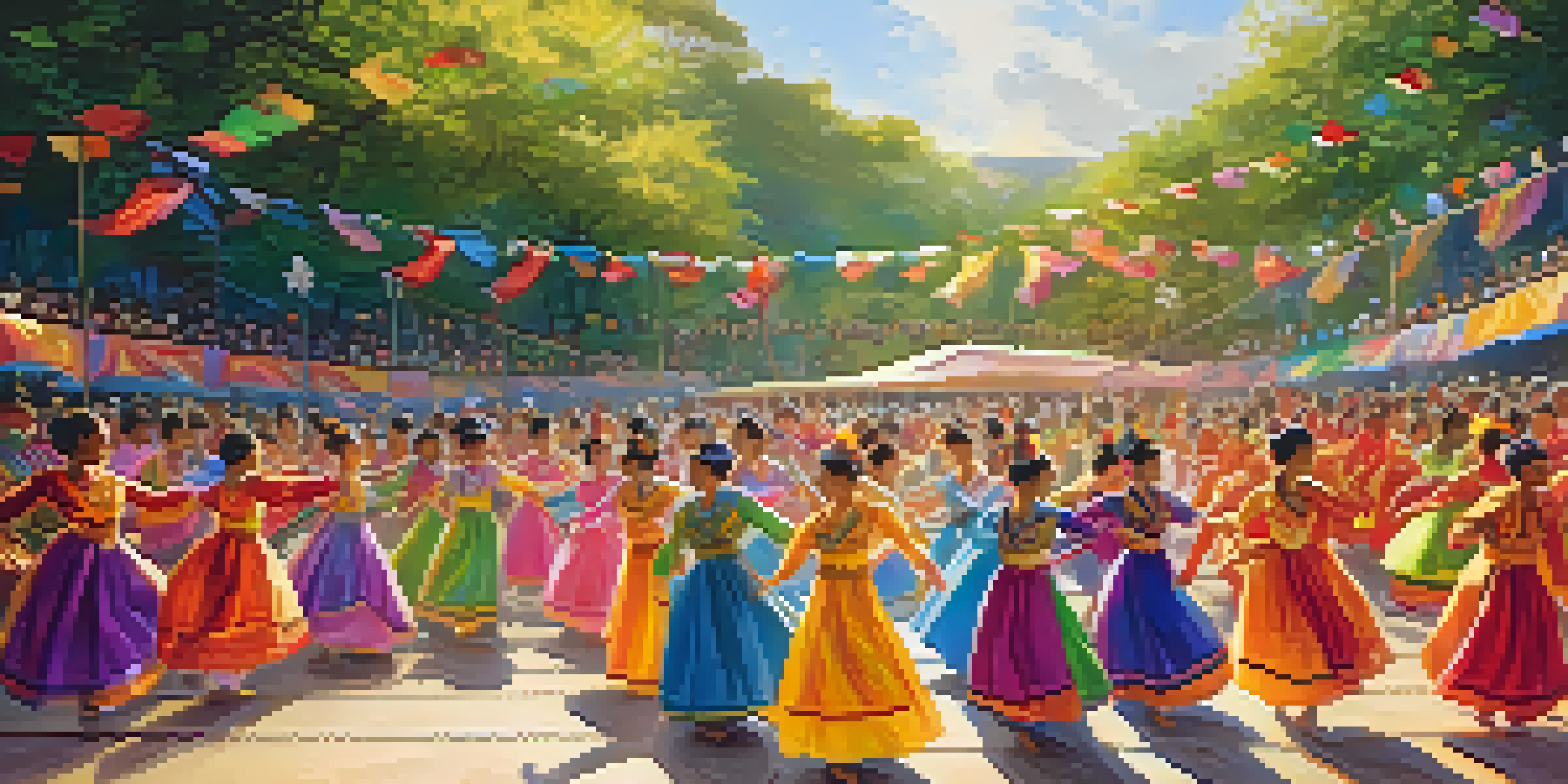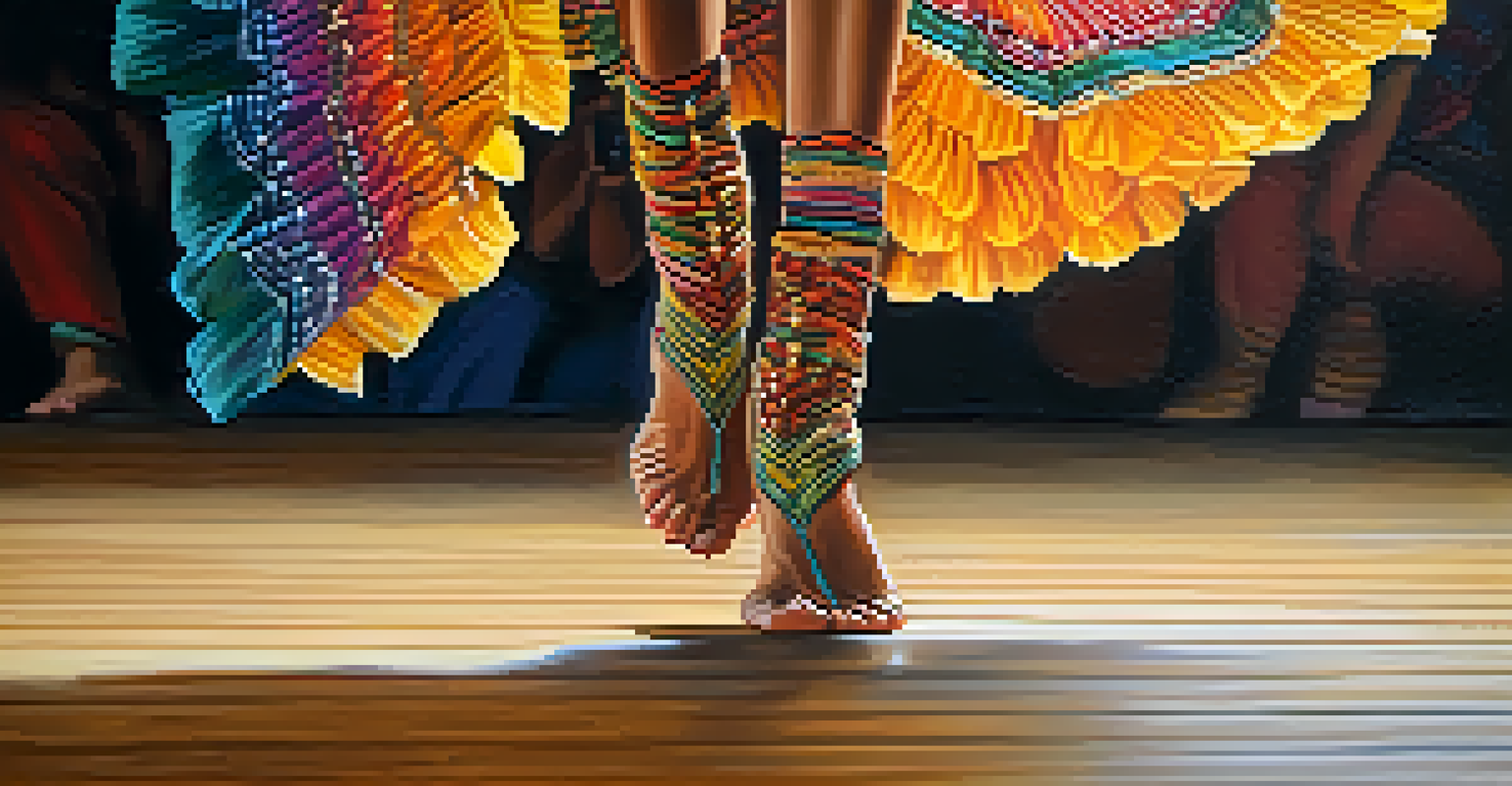Exploring Global Dance Festivals: A Cultural Celebration

Dance Festivals: A Window into Global Cultures
Dance festivals are more than just performances; they serve as vibrant reflections of cultural heritage. Each festival showcases the unique traditions, stories, and rhythms that define a community. For instance, the Rio Carnival in Brazil is not just about samba; it's a celebration of Brazilian identity and unity.
Dance is the hidden language of the soul.
Attending these festivals allows participants to experience diverse cultures firsthand, transcending language and geographical barriers. Imagine being surrounded by colorful costumes, infectious music, and the electric energy of dancers who’ve spent years perfecting their craft. This immersive experience fosters a deeper understanding and appreciation for different cultural backgrounds.
Moreover, these gatherings often promote cultural exchange, where local and international artists collaborate and learn from each other. This not only enriches the festival experience but also helps preserve traditional dance forms that might otherwise fade away. In essence, dance festivals are living museums of culture, inviting everyone to join in the celebration.
Top Dance Festivals Around the World
From the bustling streets of New Orleans to the serene beaches of Bali, each dance festival has its own unique flavor. The New Orleans Mardi Gras, for example, blends jazz, zydeco, and vibrant parades, creating an unforgettable atmosphere. Meanwhile, the Ubud Village Jazz Festival in Indonesia showcases not only local talent but also international artists, all against a backdrop of stunning rice paddies.

In Europe, the Edinburgh Festival Fringe stands out as a melting pot of performances, including dance, theatre, and comedy. Dancers from all over the globe gather to share their artistry, fostering connections and creative collaborations. Each festival brings together diverse dance styles, from contemporary to traditional folk, offering something for everyone.
Dance Festivals Reflect Cultures
Dance festivals serve as vibrant reflections of cultural heritage, showcasing unique traditions and stories that define communities.
These festivals are not just limited to grand stages; many also feature workshops and community events, giving attendees a chance to learn and participate. Whether you're a seasoned dancer or just a curious spectator, these opportunities enhance the festival experience and deepen your connection to the art form.
The Role of Dance in Cultural Identity
Dance is a powerful expression of cultural identity, often rooted in historical events, social movements, and community values. For many cultures, traditional dances serve as a means of storytelling, passing down myths and legends through generations. For example, the Maori haka from New Zealand is not just a dance; it’s a profound expression of pride and unity, often performed to honor guests or mark significant occasions.
Dance is the joy of movement and the heart of life.
Furthermore, dance festivals provide a platform for marginalized voices, allowing them to share their narratives through movement. In many cases, dance becomes a tool for social change, raising awareness about important issues and promoting cultural pride. The inclusion of diverse dance forms in festivals helps challenge stereotypes and fosters a sense of belonging.
Ultimately, the dance festival experience reminds us that movement is a universal language. It connects us to our roots while also encouraging us to embrace the richness of other cultures. Through dance, we celebrate our differences and find common ground, uniting people from all walks of life.
The Impact of Technology on Dance Festivals
In recent years, technology has transformed the way we experience dance festivals. Live streaming, for instance, has made it possible for audiences around the globe to enjoy performances from the comfort of their homes. This accessibility has opened doors for those who may not have been able to attend in person, allowing them to participate in the cultural celebration.
Additionally, social media plays a crucial role in promoting these festivals, with platforms like Instagram and TikTok showcasing dancers and performances in real-time. This not only boosts the visibility of the events but also encourages a new generation of dancers to engage with traditional and contemporary forms. Hashtags like #DanceFestival or #CulturalCelebration help create a sense of community among participants and fans alike.
Community Building Through Dance
These festivals foster community bonds and stimulate local economies, bringing people together to celebrate their shared love for movement and culture.
However, while technology enhances our experience, it’s essential to remember the core essence of these festivals: the live, shared experience of dance. The energy of a crowd, the thrill of seeing a performance unfold before your eyes, and the joy of connecting with fellow festival-goers are irreplaceable aspects that technology cannot replicate.
Dance as a Tool for Community Building
Dance festivals often serve as catalysts for community building, bringing people together to celebrate their shared love for movement and culture. These events create spaces where individuals can bond over their passion for dance, fostering friendships and connections that extend beyond the festival itself. In many cultures, communal dancing is a fundamental part of social interaction, reinforcing bonds among participants.
Moreover, local dance festivals can have a significant economic impact on their host communities, attracting tourists and stimulating local businesses. Restaurants, hotels, and shops often benefit from increased foot traffic, creating a win-win situation for both visitors and residents. This economic boost can lead to more funding for future cultural events, enhancing the community's cultural landscape.
Ultimately, dance festivals remind us of the importance of community and togetherness. They provide opportunities for collaboration, celebration, and collective expression, reinforcing the idea that we are stronger when we come together to share our passions.
Sustainability in Dance Festivals
As awareness of environmental issues grows, many dance festivals are taking significant steps towards sustainability. From reducing waste to promoting eco-friendly practices, these festivals are committed to minimizing their environmental impact. Initiatives such as using biodegradable materials for food and beverage services or encouraging carpooling among attendees help create a more sustainable festival experience.
Additionally, some festivals incorporate educational components, raising awareness about environmental conservation through workshops and performances. This not only highlights the importance of sustainability but also inspires attendees to adopt eco-friendly practices in their own lives. By highlighting the connection between art and the environment, dance festivals can play a vital role in shaping a more sustainable future.
Sustainability in Dance Events
Many dance festivals are adopting sustainable practices to minimize their environmental impact while promoting awareness about conservation.
Ultimately, the journey towards sustainability in dance festivals reflects a broader cultural shift towards environmental consciousness. As artists and audiences alike become more mindful of their impact, the dance community can lead by example, proving that cultural celebrations can thrive while also protecting the planet.
The Future of Dance Festivals
Looking ahead, the future of dance festivals appears dynamic and full of potential. As they continue to evolve, we can expect to see more innovative approaches to programming, blending genres and styles to create unique experiences. Festivals may increasingly prioritize inclusivity and diversity, ensuring that all voices are represented on stage.
Moreover, as global connectivity increases, dance festivals will likely embrace cross-cultural collaborations, allowing artists from different backgrounds to come together and create something new. This fusion of ideas not only enriches the festival experience but also sparks creative dialogue between communities, fostering understanding and respect.

In this rapidly changing landscape, one thing remains clear: dance festivals will continue to be essential cultural touchstones. They provide opportunities for expression, celebration, and connection, reminding us of the universal power of dance to bring people together, celebrate diversity, and create lasting memories.